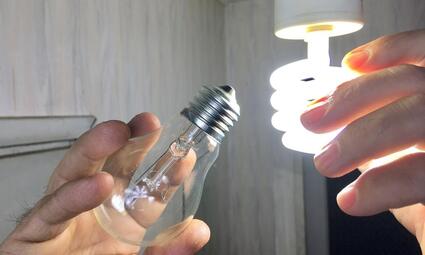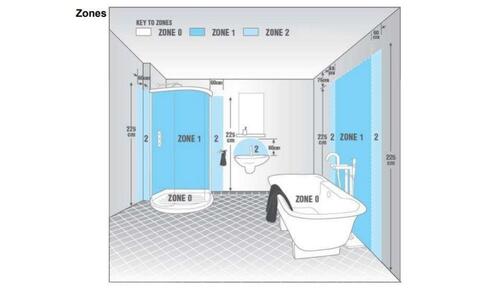
Introduction
On a busy day, you hardly spend a few minutes in your bathroom. Even on weekends, you might rarely spend long hours relaxing in a bathtub. Hence, when you think of the bathroom in your home, it’s reasonable not to think of it as a room that zaps energy. Think again.
Did you know that the water used in a bathroom plays a significant role in driving up your energy bills? Baths and showers account for an enormous 34% of water consumption in a home, and toilet flushing accounts for another hefty 22%.
Obviously, saving water will reduce your water bill (if the water in your home is on a water meter). Importantly, it will also reduce your energy bills.
- What Are the Different Bathroom Electric Zones in the UK and IP Ratings?
- Tips for Saving Energy in Your Bathroom
- How Are Bathroom City Products Energy Efficient?
- Summary
- Shop Energy-Efficient Electrical Bathroom Appliances
Navigate to any section of this post by clicking on the links above
What Are the Different Bathroom Electric Zones in the UK and IP Ratings?
Electric zones are areas inside a bathroom where electrical appliances must provide a level of protection against moisture and water. The zone number indicates the quantity of water likely to be present. The picture below provides a clear explanation of the different bathroom electric zones.

Zone 0
This zone includes the area inside the bathtub and the shower tray. In the absence of a shower tray, this zone includes the area 10cm high from the bathroom floor level extending to 1.2m around the shower head.
Zone 1
The width of the zone 1 area is the same as that of the zone 0 area, extending to a height of 2.25m above the bathroom floor level.
Zone 2
The height of the zone 2 area is the same as that of the zone 1 area, which is 2.25m. This area extends to 0.6m around the bath.
IP Ratings
IP Ratings are represented using two digits, for example, IP33.
The first digit indicates the protection level against the incursion of foreign bodies, such as dust, fingers, tools, etc. The second digit indicates the protection level against the incursion of liquids. So, for instance, IP33 would offer protection against solid objects of dimensions greater than 2.5mm (e.g., wires and tools) and water sprayed up to 60 degrees from vertical.
This Sunbelt Sales, UK, web page gives a more detailed explanation of IP Ratings. The following tips for conserving energy have been compiled after some careful research. .
Tips for Saving Energy in Your Bathroom
1. Responsible Use of Water
The water consumption of an average household in the UK is close to 350 litres each day. And the average yearly metered water bill is a whopping £419! Evidently, everyone needs to rethink their relationship with energy and water.
Engaging in water-saving behavior inside the bathroom is the need of the hour to reduce energy bills. There’s astonishing potential to conserve water and reduce electricity bills. For instance, if every UK household reduced one minute in one shower every day (the duration of the average shower is seven-and-a-half minutes), the money saved in energy bills a year would amount to £215 million. Similarly, a lot of electricity can be saved by making a simple change: selecting the 30°C wash setting on the washing machine.
2. Energy Saving Bathroom Lights
Halogen light bulbs were banned in the UK in September 2021. Fluorescent lights are expected to be removed from store shelves by September 2023. The key reason for their discontinuance is both these lights are not energy efficient.
LEDs (Light Emitting Diodes) and CFLs (Compact Fluorescent Lamps) are energy-efficient lights. When you replace fused bulbs for your bathroom lighting, purchase LEDs or CFLs as they are more energy efficient compared to halogen and fluorescent bulbs.
Another simple yet huge energy-saving action is to always turn the light off when leaving the bathroom. It’s easy if the light switch is located close to the door. Installation of sensor lights in bathrooms is yet another surefire method of conserving energy.
3. Regular Servicing of Electrical Installations
The general perception is that electrical installations are durable and don’t need regular servicing. But that simply isn’t true.
Let’s consider an example. Even in a brand-new water heater, the build-up of sediment can be high when the water is hard. (According to Thames Water, more than 60% of UK residents live in hard water areas.) As a result, the water heater will deteriorate fast and fail in case there’s no timely maintenance check.
Likewise, the risks involved with badly maintained electric wiring are real. You can’t afford to ignore them as they could lead to damage to appliances, circuit tripping, loss of electricity, or even serious injury.
Wiring regulations BS 7671 recommend a domestic property be inspected once every 5–10 years after an electrical installation or when a property is bought/sold.
4. Check Your Extractor Fans
An extractor fan is designed to extract moisture and unclean air from your bathroom. When the blades of this high-speed fan are in motion, they’re bombarded with airborne dust particles, floating fibers, and tiny insects.
Regardless of constant technological advancements and the best efforts of manufacturers, it’s only a matter of time before even the best models will suffer from dust and grime build-up. Eventually, this build-up will impact the performance of the fan.
You can think of an extractor fan as a vacuum cleaner. Naturally, it would need regular maintenance to function properly. Any abnormal noise is the first sign that everything isn’t right.
Check your extractor fan once in three months. If there’s a build-up of dust and grime, use a clean cloth or cotton wool buds to clean the blades of the fan. This will ensure the fan will run smoothly.

5. Smart Energy Savings by Insulation
Insulating the walls of your bathroom is an effective way to prevent mould build-up. Premium-grade insulation can also control temperature, eliminate moisture, and reduce airflow.
The insulation in the exterior walls is typically robust. But the same cannot be said of the interior walls of your bathroom. So the next time you go in for bathroom renovation, consider insulating the walls too.
A thick coat of insulation will keep your bathroom warm for a longer period. As a result, you’ll conserve valuable energy – especially during the winter – and save on utility bills.
6. Spread Awareness in Your Family
Utility service providers are revising their rates upwards frequently. As household energy bills surge, millions of Brits have plunged into fuel poverty. So the burning question is How to save electricity?
It’s time you spoke with everyone at your home about the importance of conserving energy. Give them some simple energy-saving tips and remind them often to switch off the extractor fan when no one is using the bathroom.
Tell them to turn off the switches of electrical appliances not in use. It’s so much easier when everyone at your home works as a team.
Small daily changes make a notable difference. When everyone is in it together, it’s easier to drive down your utility bills.

7. Install an Electric Towel Rail
Installing an electric towel rail allows you to maximise the bathroom wall space and functionality. The main advantage of a heated towel rail is it ensures your towel is warm for drying yourself when you step out of the shower. A heated towel rail also regulates mould growth and dampness.
Contrary to popular belief, running this electrical appliance need not be expensive. You only need to use it wisely. Turn it on and off at appropriate times. It isn’t necessary to keep it on the whole day. You only need to keep it on for a few hours each day.
8. Use Smart Home Apps
A smart home app presents you with the convenience of having all the home functions in one place. With a smart home app, you can increase the energy efficiency of your water heater and save money on your utility bills.
You can reduce water wastage in your bathroom by using a digital shower head and linking it to the smart home app.
Smart technology allows you to monitor the water temperature and pressure, enabling you to reduce water consumption. You can also automatically switch off the electrical appliances in the bathroom when not in use.
9. Use an Energy-Efficient Shower Head
Water conservation in the UK is vital due to three factors: climate change, population growth, and water leaks.
Energy-efficient, low-flow shower heads have been around for 40 years. But if you’ve been using an older version, you might have the misconception that since water consumption is 25% to 30% lower, you’ll end up with a lower-quality shower. This simply isn’t true.
The newer models have permanently resolved the low water pressure issues that plagued the older models. Newer versions of energy-efficient shower heads create stronger water pressure using a mix of tiny apertures and air. As a result, you’re guaranteed a more pleasant shower.
You can rest assured that the latest shower heads will provide decent water pressure and good-quality showers. A new showerhead will also pay for itself in terms of cost savings.
10. Swap a Bath for a Shower
Showers cost a lot less to operate than baths. The main advantage of switching to a shower is it costs less to heat, and you don’t need to fill an entire tub with hot water.
While the water consumption in a long shower (more than 10 minutes) is almost equal to that of a regular dip in a bathtub, a quick shower can save a lot of water.
In fact, if everyone in the UK restricted their shower time to 5 minutes, the amount of water saved would be enough to supply one million residents a day.
11. Review Energy Providers & Their Tariffs
The ongoing crisis in the energy market due to the Russia-Ukraine conflict has resulted in all-time high energy rates. So it’s wise to start a tariff comparison and check all the tariffs available in your area.
Many energy providers offer grants or schemes that help reduce home heating and energy costs.
Use an impartial tool like Which? Switch Energy to compare tariffs and find the best provider for you.
How Are Bathroom City Products Energy Efficient?
Our premium towel rails, radiators, heaters, and extractor fans are highly energy efficient and come with extended guarantees. These appliances are trouble-free. You install them and simply forget about them. All these products present your bathroom with the perfect balance of heat and functionality. You also get to choose from an assortment of sizes and innovative designs.
Shop Energy-Efficient Electrical Bathroom Appliances
You need to give serious thought to the bathroom if you want to cut down on your utility bills. You might think that the basin, toilet, bathtub, and shower don’t play a major role in energy consumption. But your bathroom is precisely the place where conserving energy is really possible. If you’re wondering how to save electricity in the bathroom, all you need to do is reduce water wastage. Lower energy bills will soon follow. At Bathroom City, we stock designer appliances, making it easy to choose the perfect bathroom radiator, towel rail, or extractor fan. Our range of energy-saving appliances will complement your bathroom aesthetics.
Other Articles That You May Enjoy Reading